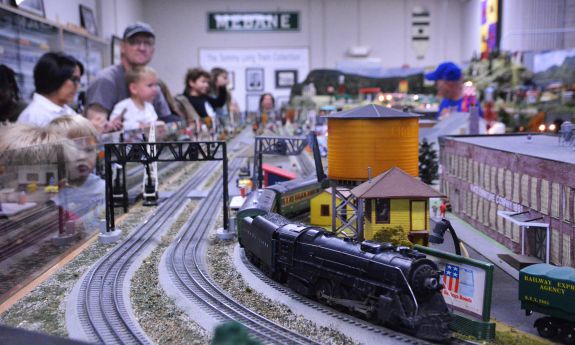Keeping Memories on Track with Model Trains
A Financial Analyst and late Distinguished Professor of Pediatrics at Duke shared a passion for creating joy with vintage trains

All Aboard
Located at 209 West Jackson Street in Mebane, the Mebane Train Display is open from 10 a.m.-2 p.m. on the second Saturday of each month.
Only a few months earlier, Dr. Kinney’s collection of 1940s-era Lionel O-scale trains, untouched for years, sat on shelves or in boxes in the family’s Durham home.
As a child in Cleveland, Dr. Kinney loved to lace tracks around his room and drift off to sleep as his engines pulled boxcars and tankers around his bed.
As an adult in Durham, Dr. Kinney used to set up the trains for Christmas parties decades ago, reveling in the excitement of young guests.
As a longtime pediatric hematologist at Duke, Dr. Kinney, a Duke graduate, led influential studies of sickle cell disease and developed approaches to spot and treat it in children. A father of two, he also set up a summer camp for kids with chronic diseases.

Four years after Dr. Kinney’s death at the age of 76, and nearly 30 years since Dr. Kinney had set them up last, Brenda decided the trains needed a new home.
That’s when Travis Washburn got a call.
A model train enthusiast since childhood, Washburn is a member of the Train Group of Mebane.
The non-profit group’s volunteers maintain and operate the Mebane Train Display, which has been open on the second Saturday of each month since 2012, wowing visitors young and old.
In March, Brenda, who found the Train Group of Mebane’s website, called Washburn to ask about donating Dr. Kinney’s old trains.
While the group doesn’t accept donated pieces to be added to its collection, it will accept donations of trains which the group sells for future funding needs.

Washburn was moved by Brenda’s stories about Dr. Kinney’s trains and offered for the group to take unusual step of restoring and featuring the collection during one of their Saturday public openings, prior to the collection’s eventual sale to other collectors.
Dr. Kinney’s collection of around 10 vintage engines, 30 freight cars, and several tiny water towers and buildings was in rough shape.
For months, during regular Tuesday night gatherings, group members carefully took the trains apart, re-soldered wiring, cleaned surfaces and oiled mechanical parts.
“They just needed some TLC,” Washburn said. “Every time we get our hands on one of these old trains, we’re honoring somebody. We were that little kid at some point.”

Once the trains had new life, Washburn invited Brenda to the Mebane Train Display’s monthly open house in November.
That was where Dr. Kinney’s collection, which is now being readied for sale, would make a one-time-only appearance on the tracks.
Joined by her son, Thomas C. Kinney, and a large group of friends and relatives, Brenda was elated to see her husband’s trains – including her favorite New York Central passenger line – move gracefully through small towns, forests and tunnels.
“I had no idea they could take what we gave them and make them into these shiny, gorgeous things,” she said.
Watching with a smile, Washburn was equally thrilled to see Dr, Kinney’s collection spread joy again, and with a small touch from the doctor himself.
Model train operators of trains from this era often create smoke by putting small waxy pellets into their engines.
As the machinery heats up, the slowly burning pellets begin to smoke.

When Washburn started running Dr. Kinney’s trains during last month’s open house, wisps of white smoke rose from the engines.
The smoke most likely came from decades-old pellets left from the last time Dr. Kinney watched his trains roll by.
Send story ideas, shout-outs and photographs through our story idea form or write working@duke.edu.
Follow Working@Duke on X (Twitter), Facebook and Instagram and subscribe on YouTube.